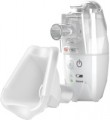Medicine container
The nebuliser's built-in medicine reservoir volume is a crucial consideration. It's important to align this parameter with medical guidelines for the prescribed treatment. A too-small capacity may require frequent refilling, disrupting the treatment process.
Also, knowing the volume of the reservoir and the nebulization rate (see below), it is possible to estimate the operating time of the nebuliser on a single refill.
Nebulization rate
The nebuliser's nebulization capacity per minute.
The ideal nebulization rate can differ based on factors such as the patient's health condition, the type of disease, and the composition of the inhaled medication, as outlined in medical guidelines. This rate is crucial in assessing the inhaler's effectiveness for specific situations and also influences how long the device operates on a single medication refill.
Some models have a nebulization speed control — in such cases, the maximum value is usually indicated in the characteristics.
Particle size
The aerosol generated by a nebuliser contains droplets of varying sizes. Smaller droplets have an easier time reaching the narrow passages of the bronchi, delivering the medicinal substance deeper into the respiratory system. For optimal therapeutic effects, it is recommended that droplet sizes do not surpass 5 microns. It's worth noting that during the atomization process, particles may vary in size, and their values are often expressed as a range.
Medium particle size (MMAD)
Since not all particles have the same size, this paragraph indicates exactly the average, most common particle size when splitting in this inhaler. Accordingly, lower values allow easier and deeper penetration into the bronchi.
Nozzles
Types of nozzles included in the delivery of the nebuliser.
—
The mask for adult. A mask is a dual-purpose nozzle covering both the mouth and nose, typically secured with a strap. It ensures effective drug inhalation, accommodating variations in breathing patterns. Masks are versatile, suitable for use during sleep or unconsciousness. However, their larger size may hinder portability when carrying them with a nebuliser (refer to "Purpose"). Despite their convenience, specialized devices offer higher aerosol concentration. This type of mask is tailored for the average adult.
—
Children's mask. Reduced version of the mask, designed for children. The design may provide additional decorative elements (see "Appearance for children"), and in terms of functionality and main features, such masks do not differ from the adults described above.
—
Nozzle for nose. A drug delivery nozzle for the nose typically features a distinctive "fork" shape with two separate protrusions inserted into the nostrils. These protrusions may gently compress the nasal septum, ensuring comfortable usage. These devices are particularly effective for treating conditions focused on the nasal cavity, such as rhinitis, as they provide a higher medicine concentration compared to masks. Additionally, nasal nozzles are more compact for easy storage.
— Nozzle for mouth.
...An inhalation nozzle designed for drug administration through the mouth is a specialized device that offers a higher concentration of the active substance compared to a mask. This is particularly beneficial for intensive treatment of the oral cavity or larynx. Despite their small size, these nozzles are well-suited for use with pocket nebulisers. However, a drawback is the requirement for conscious patient participation, as they need to securely hold the tube with their lips and inhale through the mouth. While not as convenient as a mask, it somewhat restricts the application scope.Power source
— Mains.
Operating on a standard household network of 230 V, this option enables the creation of nebulisers with versatile power and performance. With constant voltage supply, there's no concern about battery depletion during use. However, it comes with the drawback of requiring a power outlet and limiting mobility. As a result, mains power is commonly employed in stationary nebulisers (refer to "Purpose") but is rarely found in portable models.
— Batteries.
Powered by replaceable batteries of a standard size — most often AA. This self-contained power source enables nebuliser use even in remote locations, providing complete independence from civilization. While quick battery replacement is possible with a spare, it limits the creation of high-power devices. Typically used in pocket models (refer to "Purpose"), this option incurs additional costs, requiring the purchase of disposable spare cells or relatively expensive rechargeable batteries. Moreover, finding batteries can be more challenging than locating a 230 V outlet for device charging, a drawback compared to built-in batteries (see below).
— Battery. Powered by its own original battery, which may be non-removable. Like the batteries described above, this option is intended mainly for compact pocket models; at the same time, batteries can have a fairly high power and work normally even with stationary nebulisers. Their advantages
...are low cost and ease of use: instead of regularly buying and changing batteries, it is enough to periodically charge the device. Among the shortcomings, it is worth noting the impossibility of quickly replacing the battery — a dead battery has to be recharged, which takes time and the availability of a source of electricity. On the other hand, the specifics of the use of most nebulisers is such that this disadvantage is not critical in most cases.
Note that there are models with combined power source — mains/batteries or mains/battery. This combination allows you to combine the advantages of both options and compensate for the shortcomings, and also makes the device as versatile as possible — for each individual case, you can choose the best power option.
